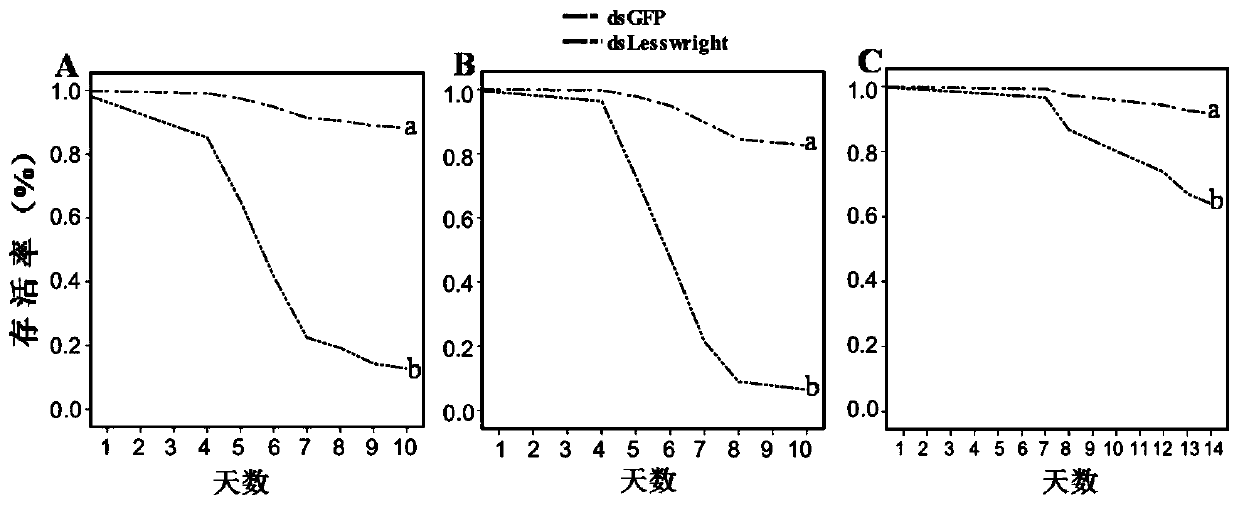Target gene for controlling epilachna vigintioctopunctata and application of target gene for controlling epilachna vigintioctopunctata
A twenty-eight-spot ladybug, target gene technology, applied in the fields of application, genetic engineering, plant genetic improvement, etc., can solve the problems of no insecticidal activity, no research on the gene function of the twenty-eight-spot ladybug, and achieve Good effectiveness and sensitivity, environmental friendliness, and easy operation
- Summary
- Abstract
- Description
- Claims
- Application Information
AI Technical Summary
Problems solved by technology
Method used
Image
Examples
Embodiment 1
[0031] The data processing method of following embodiment: For the result analysis that two types of dsRNA carry out bioassay to ladybug Solanum 28, use Excel 2010 to carry out statistics on the survival rate of ladybug 28, utilize SPSS 19.0 software Cox regression analysis was used to draw the graph, and the difference analysis between different concentrations was analyzed by single factor analysis. For the analysis of changes in the expression of target genes after RNA interference, qPCR data was used in 2 -△△Ctmethod (Ct represents the number of cycles) for calculation. Data analysis was performed using SPSS 19.0 software using one-way analysis of variance. Example 1 Obtaining of dsRNA synthesized by the Lesswright kit of growth and development-related genes
[0032] We constructed the transcriptome library based on the genome of the ladybug Solanum solani, and then based on the constructed transcriptome library, researched and screened the genes related to the growth and...
Embodiment 2
[0050] Example 2 The inhibitory effect of dsRNA on ladybug Solanum solani
[0051] 1. Application of the dsRNA synthesized by the kit in inhibiting the growth and development of the ladybug Solanum solani
[0052] Feeding group of ladybug dsLesswright: 10 1st instar larvae of ladybird solanum were placed in a petri dish with filter paper and humidified cotton balls. Soak circular eggplant leaves with a diameter of 12 mm in dsLesswright solutions with a concentration of 100 ng / μL, 200 ng / μL and 500 ng / μL for 1 min, air-dry them at room temperature for 1 h, and then feed the larvae. Two days after the leaf discs, the larvae were fed with normal eggplant leaves.
[0053] Ladybug dsGFP feeding group: 10 1st instar larvae of Ladybug solani were placed in a petri dish with filter paper and humidified cotton balls. Soak circular eggplant leaves with a diameter of 12 mm in the dsGFP solution synthesized by the kit for 1 min, air-dry them for 1 h, then feed the larvae, replace the le...
Embodiment 3
[0062] Example 3 dsLesswright inhibits the expression of the Lesswright gene in ladybird Solanum solani 1. Experimental method
[0063] On the 2nd and 4th day after starting to feed on dsRNA, the 1st instar larvae of Ladybug solani treated with 250ng / μL dsLesswright and dsGFP were collected, and 3 biological replicates were collected for each treatment. The RNA of the lady beetle was extracted and collected, then reverse-transcribed into cDNA, and diluted 10 times as a template for qPCR. Relative quantitative qPCR analysis was performed with P5 and P6 as primers. The qPCR system is (15 μL) containing 5.25 μL of ddH 2 O, 7.5 μL of 2×SYBR Green MasterMix (BIO-RAD Inc, Hercules, CA), 4 μM primers and 1.0 μL of cDNA first-strand template. The reaction instrument for qPCR was Bio-Rad C1000 Real-Time PCR system (BIO-RAD, USA). The reaction conditions were 95°C for 5 min; 95°C for 10 s, 60°C for 30 s, 39 cycles, 3 technical replicates for each sample, and the reaction was performe...
PUM
 Login to View More
Login to View More Abstract
Description
Claims
Application Information
 Login to View More
Login to View More - R&D
- Intellectual Property
- Life Sciences
- Materials
- Tech Scout
- Unparalleled Data Quality
- Higher Quality Content
- 60% Fewer Hallucinations
Browse by: Latest US Patents, China's latest patents, Technical Efficacy Thesaurus, Application Domain, Technology Topic, Popular Technical Reports.
© 2025 PatSnap. All rights reserved.Legal|Privacy policy|Modern Slavery Act Transparency Statement|Sitemap|About US| Contact US: help@patsnap.com



